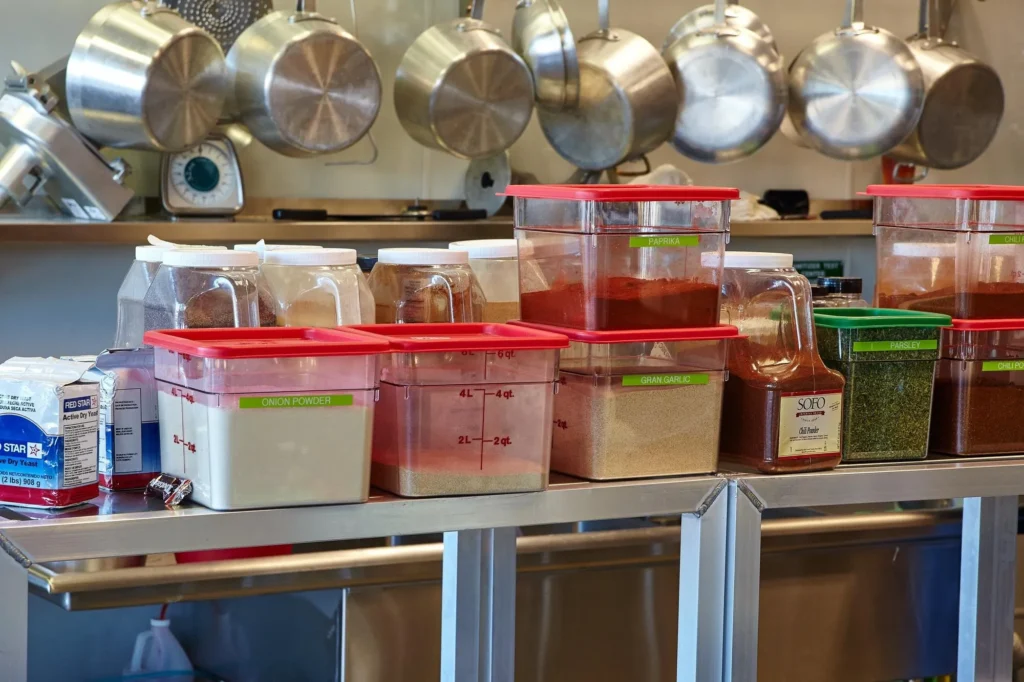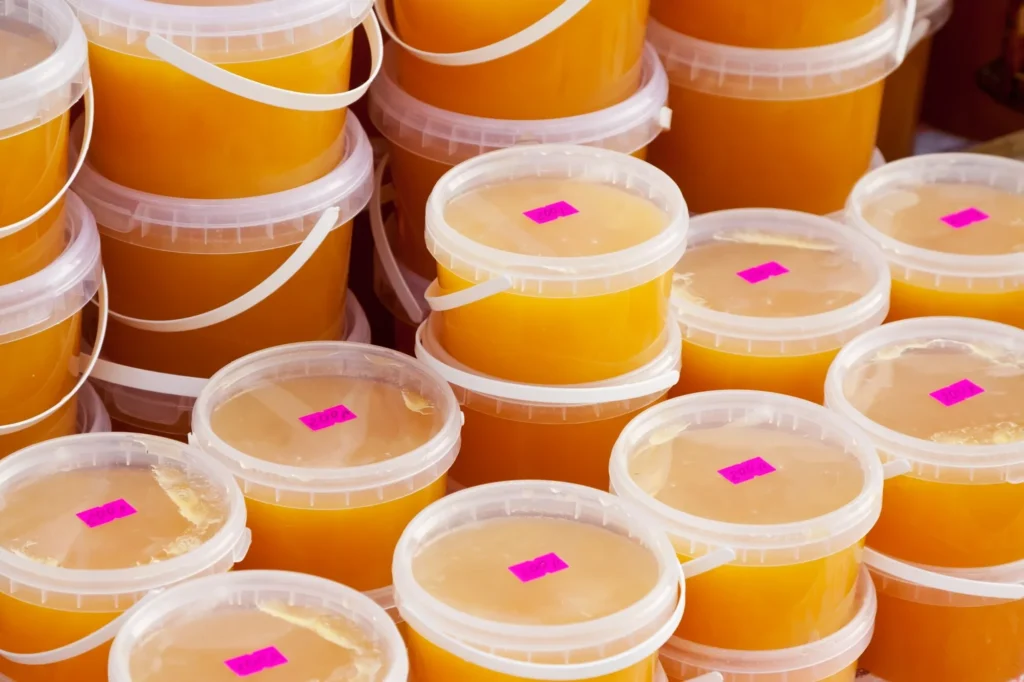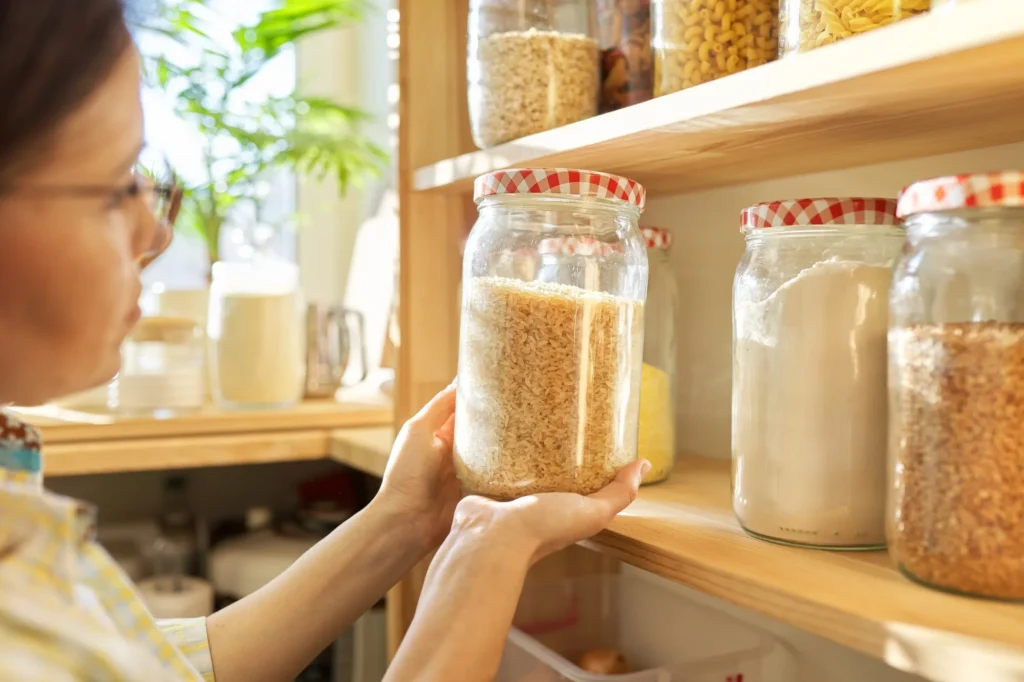Every year, about 48 million Americans get sick from foodborne illnesses. This big number shows how crucial proper food storage is. There are three main types—dry, refrigerated, and frozen. Each type needs careful handling to ensure safety. In commercial kitchens, using food storage containers in bulk helps prevent diseases caused by Salmonella and E. coli.
Refrigerated foods should be kept between 32°F and 41°F. This range stops bacteria from growing and causing spoilage or illness. For frozen foods, the temperature must be below 32°F to stop bacteria. With food storage containers bulk purchases, restaurants can better control temperatures to ensure food is safe.
Innovations like Mightylite insulated food carriers keep food at the right temperature for up to 5 hours. This isn’t just about equipment. It’s about building a culture of safety in every kitchen staff’s routine. It includes following the FIFO rule and keeping storage areas clean and well-labeled. Each step is key in stopping food contamination and keeping everyone healthy.
Introduction to Food Storage Containers in Bulk
If you’re a professional chef or own a restaurant, knowing about affordable bulk food containers is key. These containers help store large amounts of ingredients safely. They also make your kitchen more efficient by saving space.
Buying wholesale food storage containers is a smart move. It saves money and reduces the time you spend shopping. Plus, these containers keep food safe and fresh, protecting it from contamination.
- By optimizing storage space, kitchens can handle supplies better. This makes it easier to keep track of everything and cuts down on waste.
- Different sizes of containers, like the 8-Quart Cambro Square Food Storage Container and the 13.21-Quart Tellfresh Large Airtight Superstorer, allow for precise storage. They’re perfect for anything from bulk staples to perishables.
- Cost-effective bulk containers from brands like Sterilite and Tablecraft are great for everyday use. They offer reliability and durability.
Investing in wholesale containers does more than just add convenience. It improves how ingredients are stored and handled, making operations smoother. It leads to a well-organized kitchen and upholds food safety standards.
Choosing the right food storage containers is crucial. It saves time and money, both vital for any culinary business’s success.
Types of Food Storage Containers

Choosing the right storage containers is key for any commercial kitchen. It helps in keeping food fresh and organized. We’ll look at the top materials for bulk food containers, their benefits, and how they meet different kitchen needs.
Plastic Containers
- Widely chosen for their cost-effectiveness and light weight.
- Often include gradation marks for easy monitoring of contents, enhancing the utilization of large quantity food storage containers.
- Varieties like those by Cambro, made from durable polycarbonate, are designed to withstand impact, preventing breakage.
- Some models feature tight-sealing lids, essential for preventing contamination and maintaining freshness.
Glass Containers
- Non-porous material that doesn’t absorb stains or odors.
- Chemical-free composition makes them a preferred choice for health-conscious kitchens.
- Heavier and more fragile but ideal for long-term storage of items that benefit from a clear, visible container.
Metal Containers
- Made predominantly of stainless steel for the highest durability.
- Excellent for kitchens needing robust, rust-resistant containers for staple ingredients.
- Vollrath’s models include flattened edges for a more effective lid seal, essential in busy kitchen environments.
Silicone Containers
- Offer an adaptable storage solution with their collapsible designs, saving valuable kitchen space.
- Withstand a wide range of temperatures, making them suitable for everything from freezer storage to microwave heating.
Each type of material has its own set of benefits. Whether you’re looking for durability, clarity, or flexibility, these options have you covered. Keep these features in mind to choose the best bulk food containers. This way, your kitchen can run smoothly while keeping food safe.
Factors to Consider When Buying in Bulk

When you look into kitchen storage containers and bulk food solutions, there are key things to think about. Finding the right features in containers goes beyond saving money. It also helps in making your kitchen run smoother and being more eco-friendly.
Material and Durability
The type of material affects how long containers last and which foods they’re best for. You can choose from plastic, glass, metal, or silicone. Each has its own pros and cons:
- Plastic containers: They are versatile and affordable, but make sure they’re BPA-free for safety.
- Glass containers: Great for seeing inside but be careful, they can break easily.
- Metal containers: Super durable, perfect for storing grains and dry foods.
- Silicone containers: Light and flexible, ideal for different temperatures.
Consider how long each material lasts and if it suits your kitchen’s needs and the foods you store often.
Size and Variety
The size and types of containers should fit your ingredients and portion sizes well. When choosing bulk storage, think about these points:
- Look at how often you use certain items, like wheat versus corn.
- Check how much storage space you have and organize to use it best.
- Get a variety of container sizes; big ones for bulk items and small ones for everyday use.
Cost-Effectiveness
Buying containers in bulk should save money over time and make things more efficient:
- Look at the savings in the long run. Bulk items are usually 15-30% cheaper per unit.
- Buying in bulk means going to the store less often, saving you time and gas money.
- Even though bulk containers cost more up front, they save money on food and reduce waste in the long run.
The initial cost might be high, but the savings and convenience over time make it worth it.
Taking these factors into account helps restaurant owners like you use bulk storage to save money and boost kitchen efficiency. Think about your kitchen’s needs and each container’s features before making a choice. This way, you help your business’s bottom line and how well your kitchen runs.
Benefits of Bulk Food Storage Containers

Restaurant owners and chefs gain many benefits from using bulk food storage containers. These benefits include improving efficiency and sustainability in the kitchen. Such containers keep ingredients fresh and high quality. They also help organize the kitchen well.
Economical Advantages
- Cost Reduction: Buying in bulk saves money. Using larger containers lets businesses buy more at lower prices, cutting down supply costs.
- Reduced Waste: Durable containers, like mason jars with metal lids, last longer. This avoids the need to keep buying low-quality containers.
- Efficient Resource Use: Saving time and resources on orders lets chefs and owners focus more on cooking and serving customers better.
Environmental Impact
- Sustainability: Choosing recyclable containers shows a commitment to the environment. It reduces reliance on single-use plastics, helping the planet.
- Reduction in Carbon Footprint: Reusing containers like mason jars lowers emissions. It’s better than making and throwing away single-use packaging.
Convenience and Organization
- Streamlined Storage: Bulk storage containers can be stacked. This saves space and makes the kitchen more organized and accessible.
- Versatility: These containers are great for different uses. They can hold dry staples or bulk liquids, improving kitchen efficiency.
- Customization: Containers with options for labels or color-coding help in quickly finding and using ingredients without mistakes.
Restaurant Food Storage Containers Extend the Shelf Life of Perishable Foods and Dry Ingredients
For anyone focusing on efficient kitchen operations, it’s vital to keep ingredients fresh and safe. Commercial food storage containers are more than just purchases; they’re investments in maintaining food safety and improving operations. Let’s dive into how these containers can keep perishable foods and dry ingredients at their best for longer.
Food Storage
It’s important to pick the right containers for the job. Here’s a look at how different types serve specific needs:
- Plastic Dough Boxes: Perfect for bulk dough proofing and storage. They’re around 18″ x 26″, keeping yeast active, especially for the bakery section.
- Food Boxes: These come in sizes like 12″ x 18″ and 18″ x 26″, holding 1.75 to 22 gallons. They’re great for keeping refrigerated foods fresh, from dairy to vegetables.
- Food Pails: Typically 5 gallons in size, these are best for bulk items like pickles or chopped veggies. They help in maintaining freshness and providing easy access.
- Plastic Food Pans: Available in sizes from 1/9 to full size. They can withstand up to 210°F, useful for both cooking and storage.
- Vegetable Crispers: Designed to keep produce fresh, they range from 20 to 30 gallons. They come with rinse and drain features for adhering to food safety.
- Ingredient Bins: With sizes varying from 40 to 500 cups, these bins store dry ingredients like flour and sugar, keeping bulk supplies clean and ready.
- Commercial Refrigeration: Keeping a constant temperature is key. Commercial fridges and freezers help keep food at safe temperatures, following FSA guidelines.
Using the FIFO (First In, First Out) method helps promote safety by using older stock first. This minimizes waste and keeps food quality high. Making sure containers are airtight and lids fit well is essential to prevent contamination and keep food fresh longer. By using these storage solutions, restaurant owners and chefs can greatly improve efficiency and meet high food safety standards.
Top Brands and Options for Bulk Purchase

For those running a restaurant or kitchen, finding the right best bulk food containers is vital. Many top brands provide solutions perfect for commercial kitchens. These containers meet operational needs and fit budget limits. By picking affordable bulk food containers from respected brands, food safety improves and waste decreases.
Choosing the best bulk food containers means looking for quality and value. Here are top brands and their products that shine in commercial kitchens:
- Cambro: Offers durable containers, great for both dry goods and liquids. They keep food fresh and safe from contamination.
- Click Clack: Ideal for smaller dry goods like oats and rice. Their airtight, stackable canisters help keep kitchens organized.
- Rubbermaid: Known for strong containers with tight lids. They are essential for stopping leaks and spills.
- OXO: These containers have an easy pop-button seal. They are designed for easy use and storing different bulk ingredients.
Considering the wide range of affordable bulk food containers out there is good for those in the restaurant field. Assessing specific needs and how much space is available before buying is smart. The right containers keep perishables fresh and organize dry goods. Also, choosing quality brands means containers last longer, saving money over time.
Making smart picks in bulk food storage pays off. It’s not just about saving money. It’s about keeping food safe and making operations in the kitchen run smoothly.
Maintenance and Care for Long-Lasting Use
Taking care of your mason jars, stainless steel containers, and other food storage items is key for safety and durability in the kitchen. Proper maintenance helps avoid contamination and makes these tools last longer.
Cleaning and Hygiene Tips
- Regularly clean stainless steel containers with mild detergent and warm water to prevent rust and maintain their shine.
- Ensure mason jars are thoroughly washed and dried before sealing to maintain freshness and prevent mold growth.
- Sanitize all food storage containers after use to minimize the risk of bacterial contamination.
- Implement routine checks for cracks or seals issues, especially in containers used for long-term food storage, to ensure food safety.
Storage Tips
- Avoid overcrowding in storage areas to maintain proper airflow and prevent damage to containers.
- Maintain a consistent temperature in storage areas to enhance the shelf life of perishable goods, keeping refrigerators at 32°F to 41°F and freezers under 32°F.
- Utilize the FIFO (first-in, first-out) method to keep inventory fresh and reduce waste.
- Label each food storage container with dates and contents for easy identification and efficiency in stock rotation.
By following these simple maintenance and care tips, you’re not just ensuring stored food’s safety and quality. You’re also supporting sustainability and saving money for your business. Remember, good food storage is key to stopping foodborne illnesses and protecting everyone’s health.
Conclusion
Using large quantity food storage containers not only keeps food safe and fresh longer. It also helps kitchens become more organized and work better. Move It self secure storage shows that their solutions match the varied needs for storing lots of food. This ensures food stays fresh and top-quality.
Following USDA’s Food Storage Guidelines helps kitchens stay organized and reduces waste. Innovative methods like vacuum sealing and new tech tools have changed the way we think about bulk food storage. Adding strategies such as stackable bins, using different colors, and ergonomic designs helps streamline kitchen operations. The popularity of food storage products with these features shows how valuable they are.
There’s been an increase in ergonomically designed products and the use of polyethylene for hygiene. Storage containers now come in many sizes, showing a move toward custom and space-saving options. By looking at the facts and strategies we shared, restaurant owners and chefs can make smart choices in bulk storage. These wise choices help make their kitchens more efficient, cutting down costs and boosting their business.
FAQ
Are bulk food storage containers BPA-free and safe for food contact?
Most bulk food storage containers are BPA-free and safe for food contact. Check product labels or specifications for food-safe certifications to ensure suitability.
What sizes and capacities are typically available for bulk food storage containers?
Bulk food storage containers range from 5 quarts to 55 gallons, with common options like 1-gallon, 5-gallon, and 20-gallon sizes. They are often airtight and made from food-grade materials such as BPA-free plastic or stainless steel.
Resources
https://www.bobsredmill.com/blog/healthy-living/shop-bulk-bins








